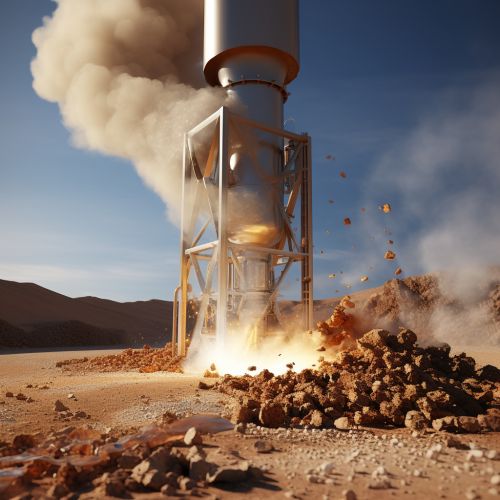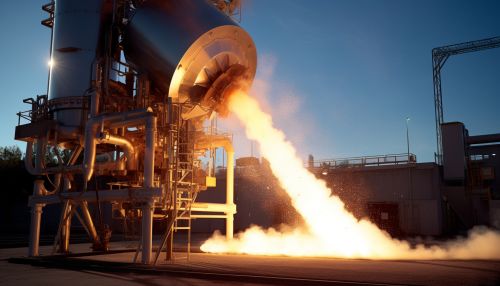Fluidized bed gasifier
Introduction
A fluidized bed gasifier is a type of gasifier that uses a fluidized bed reactor to convert solid fuels into a gaseous form, typically known as syngas. This process is achieved through a series of chemical reactions that occur at high temperatures and under controlled conditions. The fluidized bed gasifier is a significant part of the gasification process, which is a crucial component in many industrial processes, including power generation, chemical production, and waste management.


Principle of Operation
The principle of operation of a fluidized bed gasifier involves the conversion of solid fuels into a gaseous form through a process known as gasification. This process takes place in a fluidized bed reactor, which is a type of chemical reactor that uses a bed of solid particles, typically sand, and fluidizes it by passing a gas (or liquid) flow upward through the bed. The fluidization of the bed enhances the contact between the solid fuel and the gasifying agents, which are typically steam and oxygen or air. This results in a more efficient and complete conversion of the solid fuel into syngas.
Components of a Fluidized Bed Gasifier
A fluidized bed gasifier typically consists of several key components, including the fluidized bed reactor, gas distributor, solid fuel feeder, gasifier gas outlet, and solid residue outlet. Each of these components plays a crucial role in the operation of the gasifier.
Fluidized Bed Reactor
The fluidized bed reactor is the heart of the fluidized bed gasifier. It is where the gasification process takes place. The reactor is typically a vertical cylindrical vessel that contains a bed of solid particles. The particles are fluidized by the upward flow of gas, which is introduced into the bed through a gas distributor located at the bottom of the reactor.
Gas Distributor
The gas distributor is a crucial component of the fluidized bed gasifier. It is responsible for introducing the gasifying agents (steam and oxygen or air) into the fluidized bed reactor. The distributor is typically a perforated plate or a series of nozzles located at the bottom of the reactor. The design and operation of the gas distributor are critical to achieving good fluidization of the bed and efficient gasification of the solid fuel.
Solid Fuel Feeder
The solid fuel feeder is the component of the fluidized bed gasifier that introduces the solid fuel into the fluidized bed reactor. The feeder can be a mechanical device, such as a screw feeder, or a pneumatic device, such as a jet pump. The design and operation of the solid fuel feeder are critical to achieving a uniform distribution of the solid fuel in the fluidized bed and efficient gasification of the fuel.
Gasifier Gas Outlet
The gasifier gas outlet is the component of the fluidized bed gasifier that collects and removes the syngas produced in the fluidized bed reactor. The outlet is typically located at the top of the reactor. The design and operation of the gas outlet are critical to achieving a high yield of syngas and preventing the carryover of solid particles from the fluidized bed.
Solid Residue Outlet
The solid residue outlet is the component of the fluidized bed gasifier that collects and removes the solid residues produced in the fluidized bed reactor. These residues, which are typically ash and unconverted fuel, are removed from the bottom of the reactor. The design and operation of the solid residue outlet are critical to maintaining the proper operation of the fluidized bed and preventing the accumulation of solid residues in the reactor.
Advantages of Fluidized Bed Gasifiers
Fluidized bed gasifiers offer several advantages over other types of gasifiers. These advantages include high gasification efficiency, flexibility in fuel choice, ability to handle low-grade fuels, and environmental benefits.
High Gasification Efficiency
One of the main advantages of fluidized bed gasifiers is their high gasification efficiency. This is due to the excellent contact between the solid fuel and the gasifying agents in the fluidized bed, which results in a more complete and efficient conversion of the solid fuel into syngas.
Flexibility in Fuel Choice
Fluidized bed gasifiers are capable of gasifying a wide range of solid fuels, including coal, biomass, and waste materials. This flexibility in fuel choice makes fluidized bed gasifiers suitable for a wide range of applications, from power generation to chemical production and waste management.
Ability to Handle Low-Grade Fuels
Fluidized bed gasifiers can handle low-grade fuels, such as low-rank coals and waste materials, that are difficult to gasify in other types of gasifiers. This ability to handle low-grade fuels makes fluidized bed gasifiers a valuable tool for waste management and resource recovery.
Environmental Benefits
Fluidized bed gasifiers offer several environmental benefits. They produce a clean syngas that can be used as a fuel in power generation and chemical production, reducing the emissions of greenhouse gases and other pollutants. They also reduce the volume and toxicity of solid wastes by converting them into a useful fuel.
Disadvantages of Fluidized Bed Gasifiers
Despite their many advantages, fluidized bed gasifiers also have some disadvantages. These include the complexity of their design and operation, the need for careful control of operating conditions, and the potential for erosion and wear of the reactor and other components.
Complexity of Design and Operation
Fluidized bed gasifiers are more complex in design and operation than other types of gasifiers. They require a fluidized bed reactor, a gas distributor, a solid fuel feeder, a gasifier gas outlet, and a solid residue outlet, all of which must be carefully designed and operated to achieve efficient gasification of the solid fuel.
Need for Careful Control of Operating Conditions
The operation of a fluidized bed gasifier requires careful control of several operating conditions, including the temperature and pressure in the fluidized bed, the flow rates of the gasifying agents and the solid fuel, and the fluidization of the bed. Any deviation from the optimal operating conditions can result in a decrease in gasification efficiency and an increase in the production of unwanted byproducts.
Potential for Erosion and Wear
The fluidization of the bed in a fluidized bed gasifier can result in the erosion and wear of the reactor and other components. This can lead to a decrease in the lifetime of the gasifier and an increase in maintenance costs.
Applications of Fluidized Bed Gasifiers
Fluidized bed gasifiers are used in a wide range of applications, including power generation, chemical production, and waste management.
Power Generation
In power generation, fluidized bed gasifiers are used to convert solid fuels into a gaseous fuel that can be burned in a gas turbine or a steam boiler to generate electricity. This process, known as Integrated Gasification Combined Cycle (IGCC), offers several advantages over conventional coal-fired power generation, including higher efficiency and lower emissions of pollutants.
Chemical Production
In chemical production, fluidized bed gasifiers are used to produce syngas, which can be used as a feedstock for the production of a variety of chemicals, including Methanol, Ammonia, and Hydrogen.
Waste Management
In waste management, fluidized bed gasifiers are used to convert solid wastes into a gaseous fuel that can be used for power generation or chemical production. This process, known as Waste-to-energy (WTE), offers a sustainable solution for waste disposal and resource recovery.
